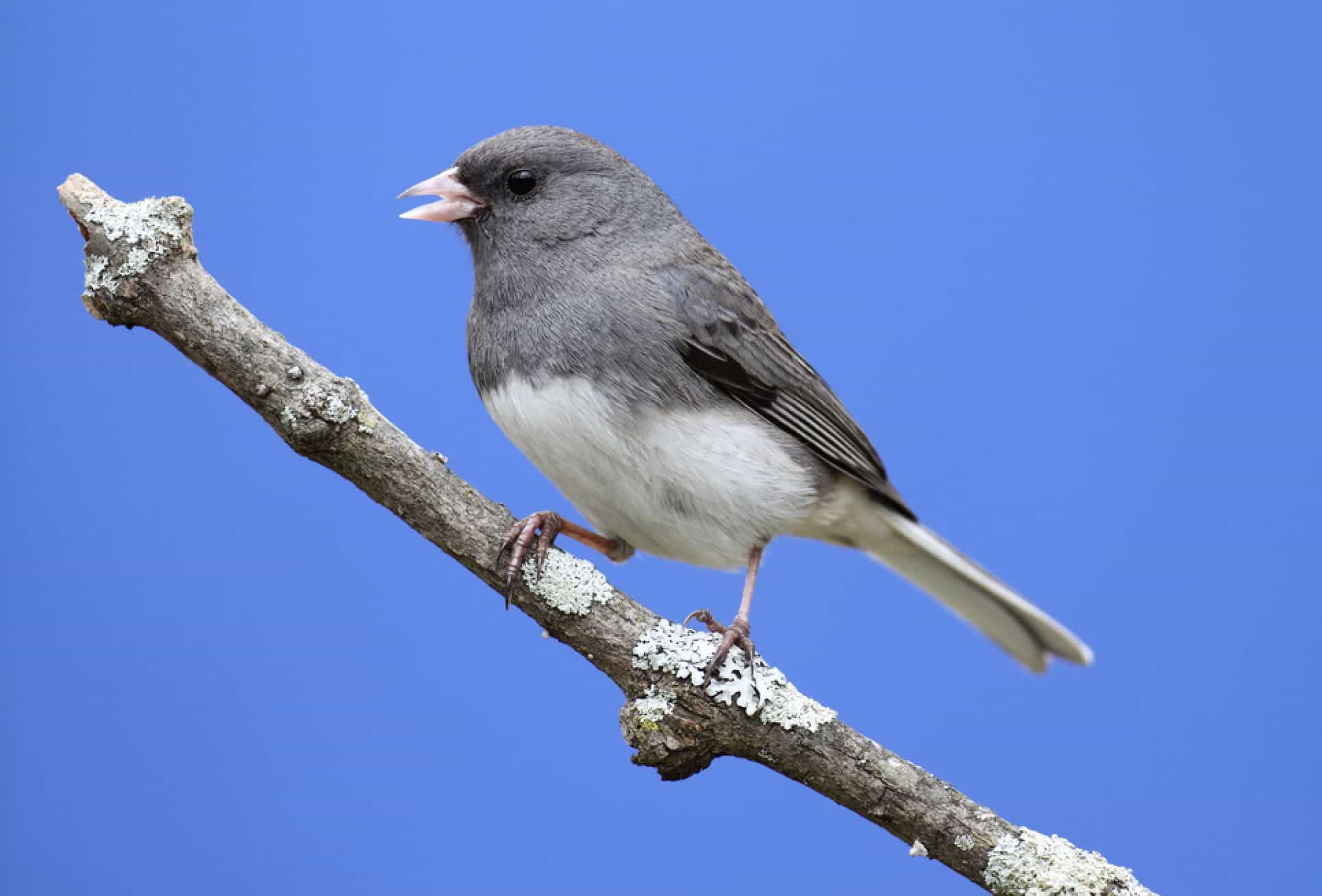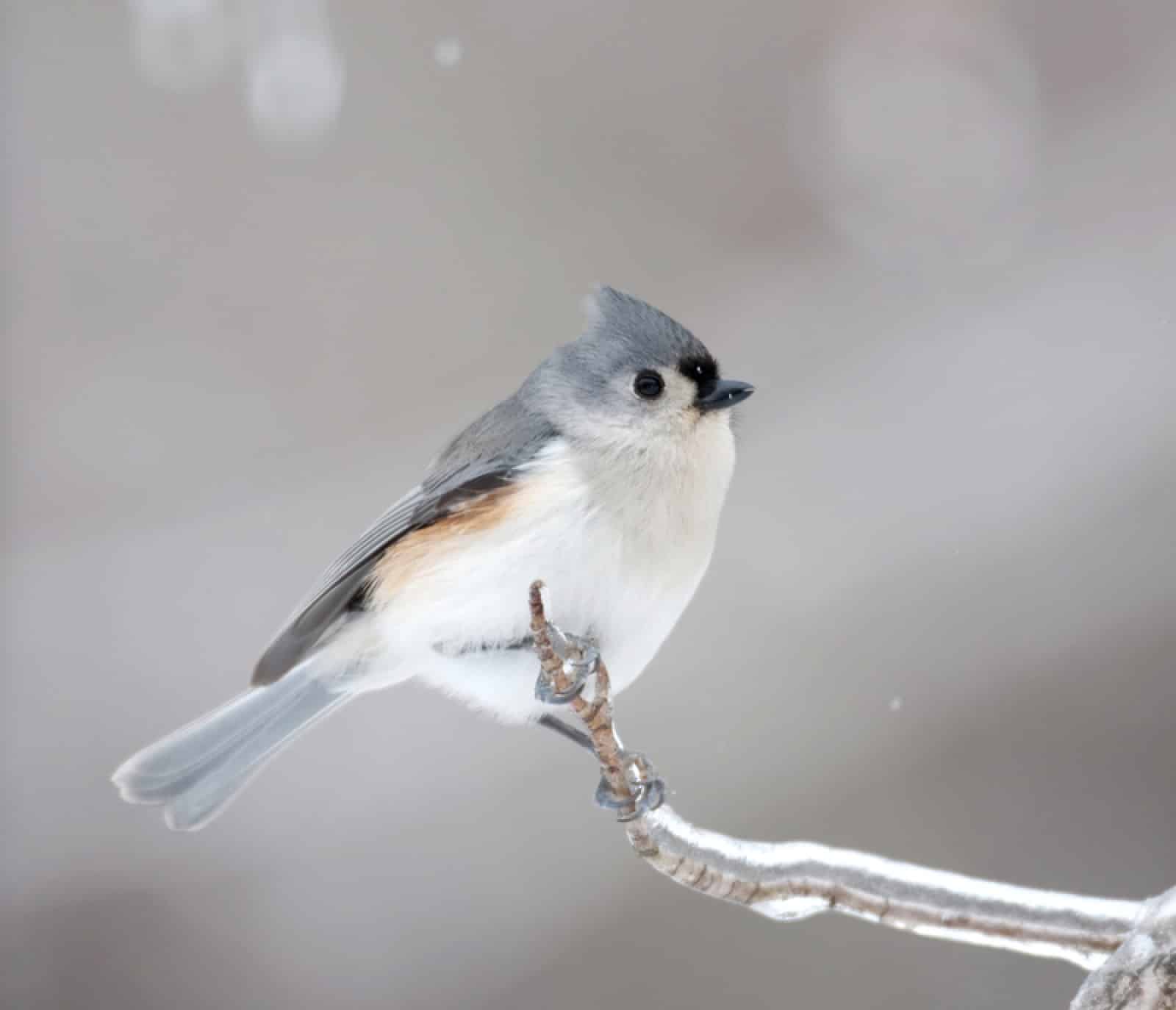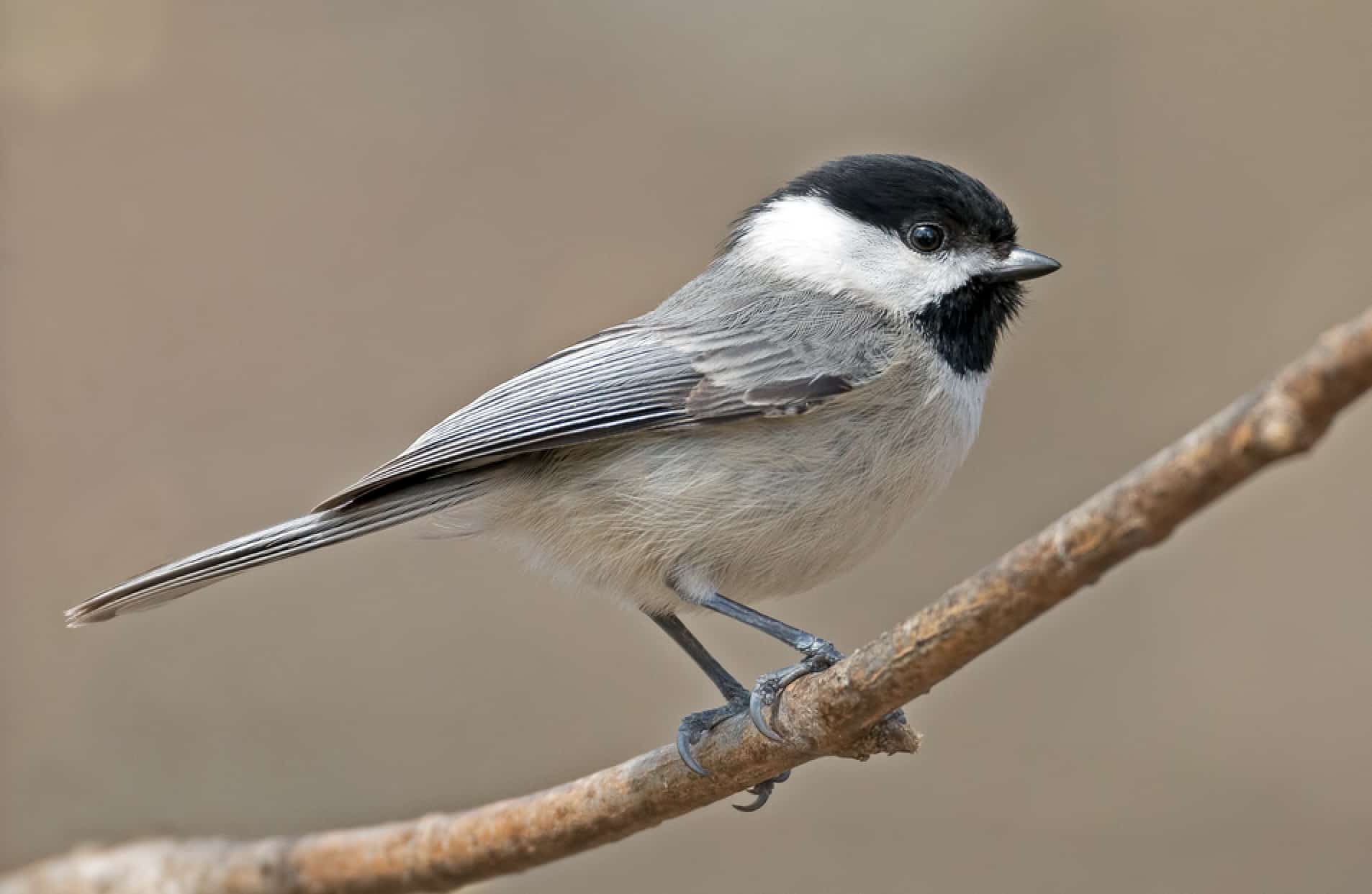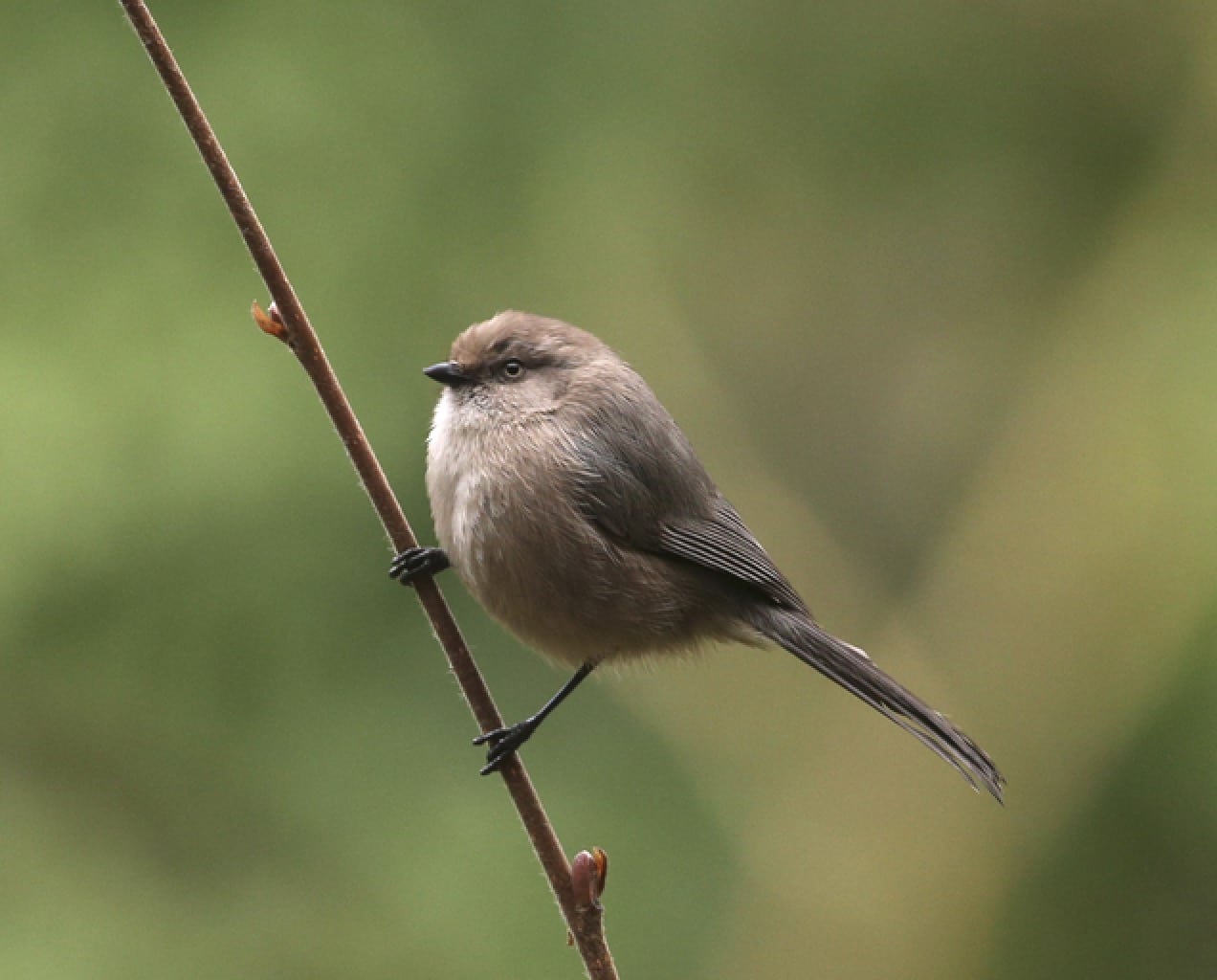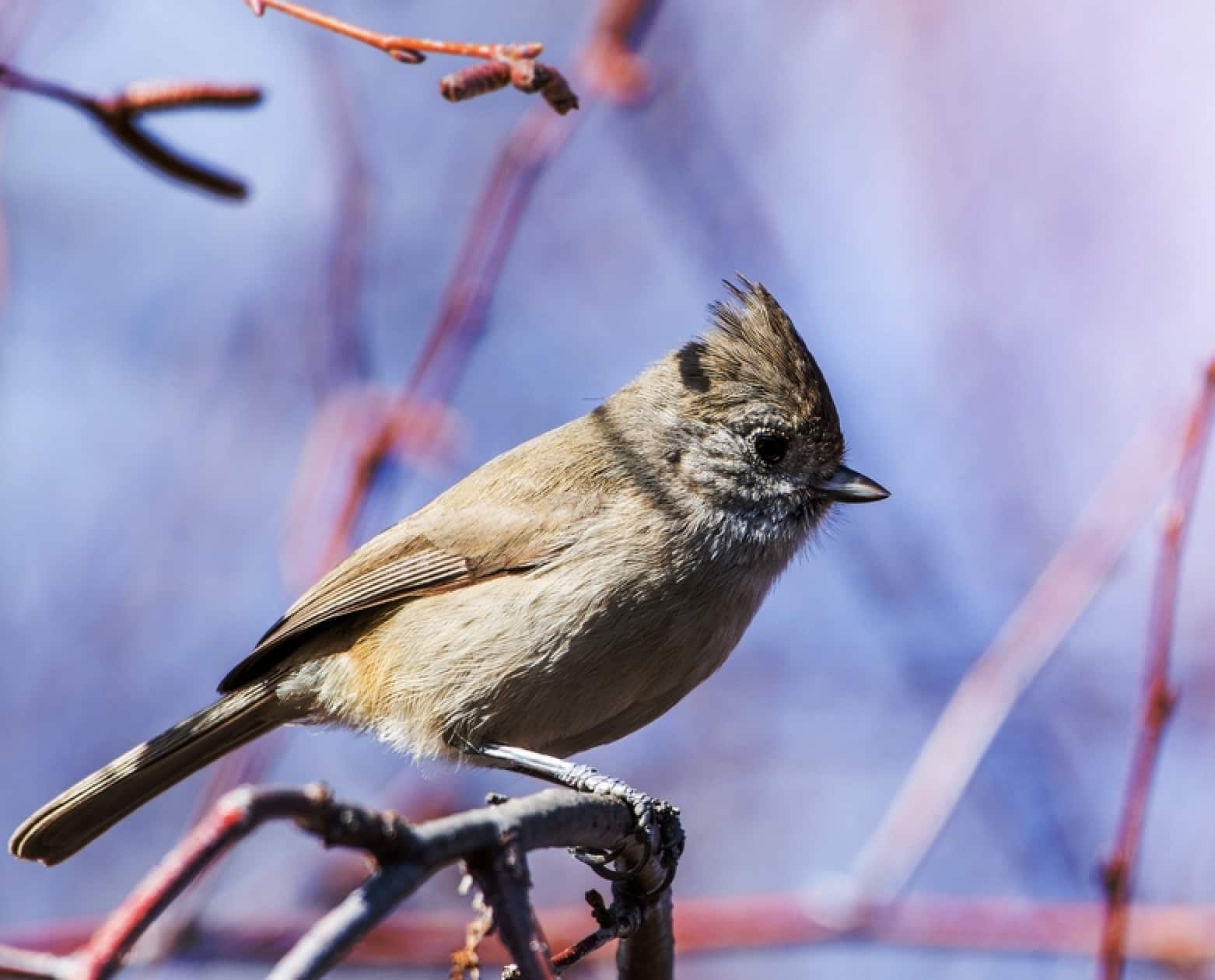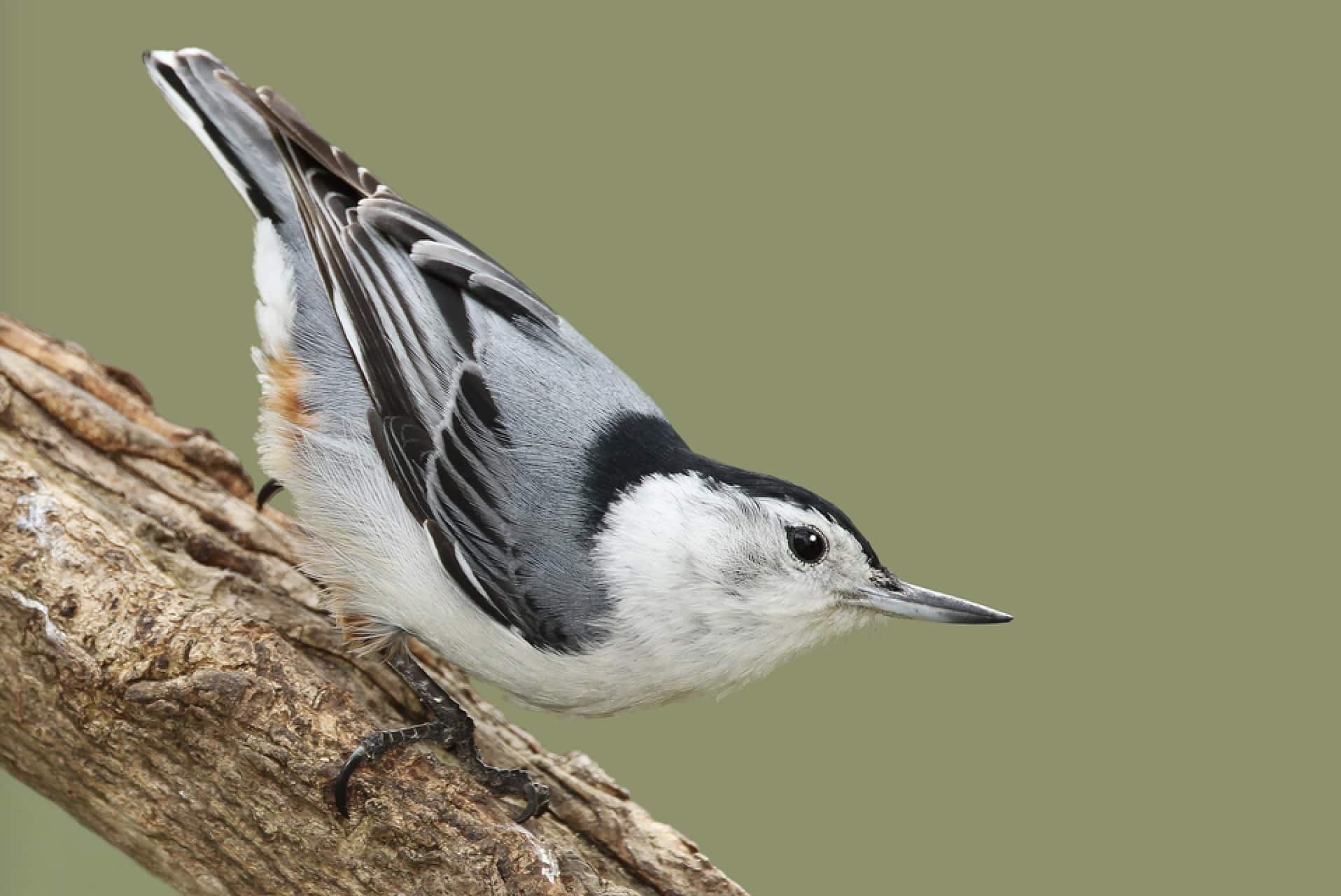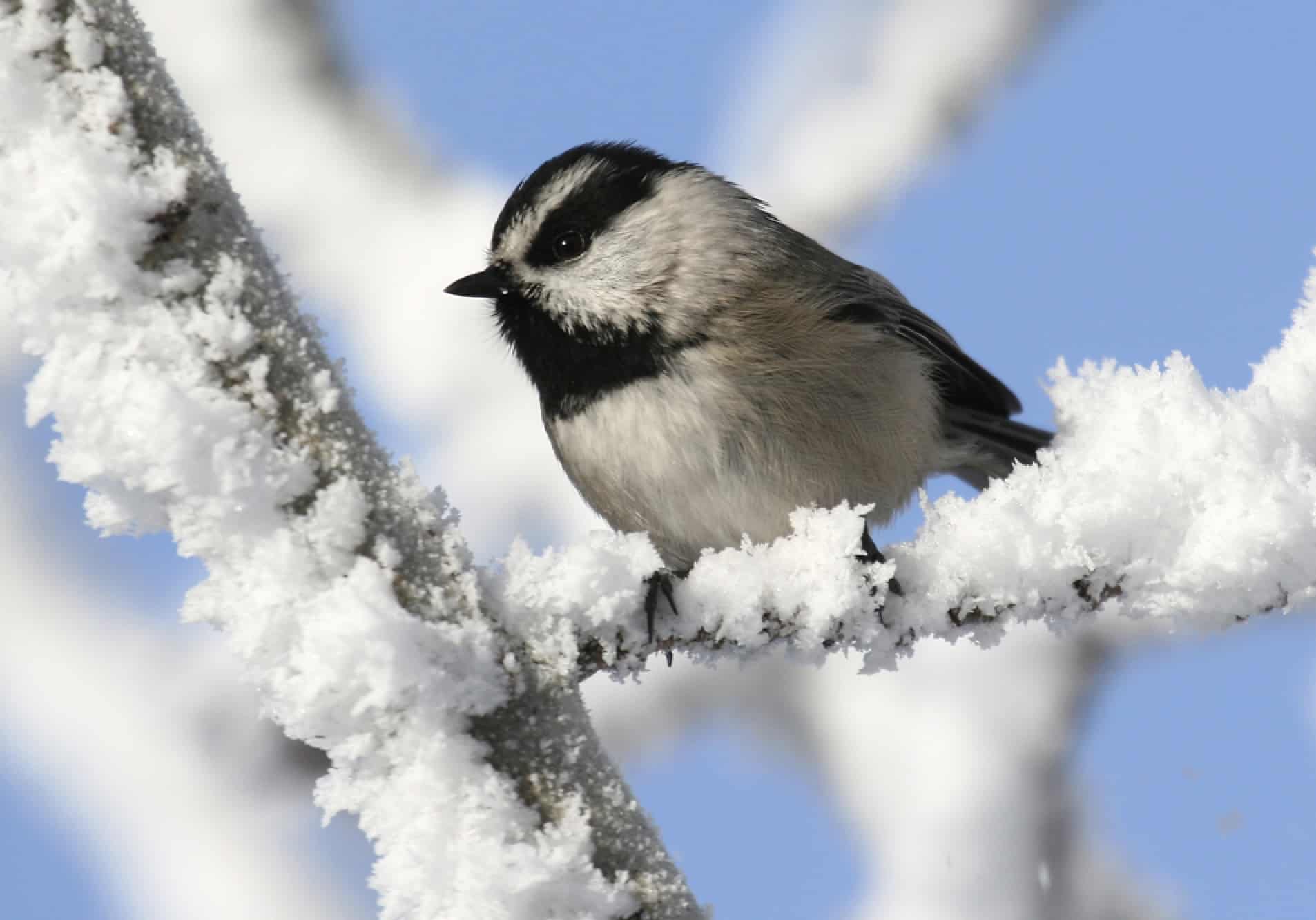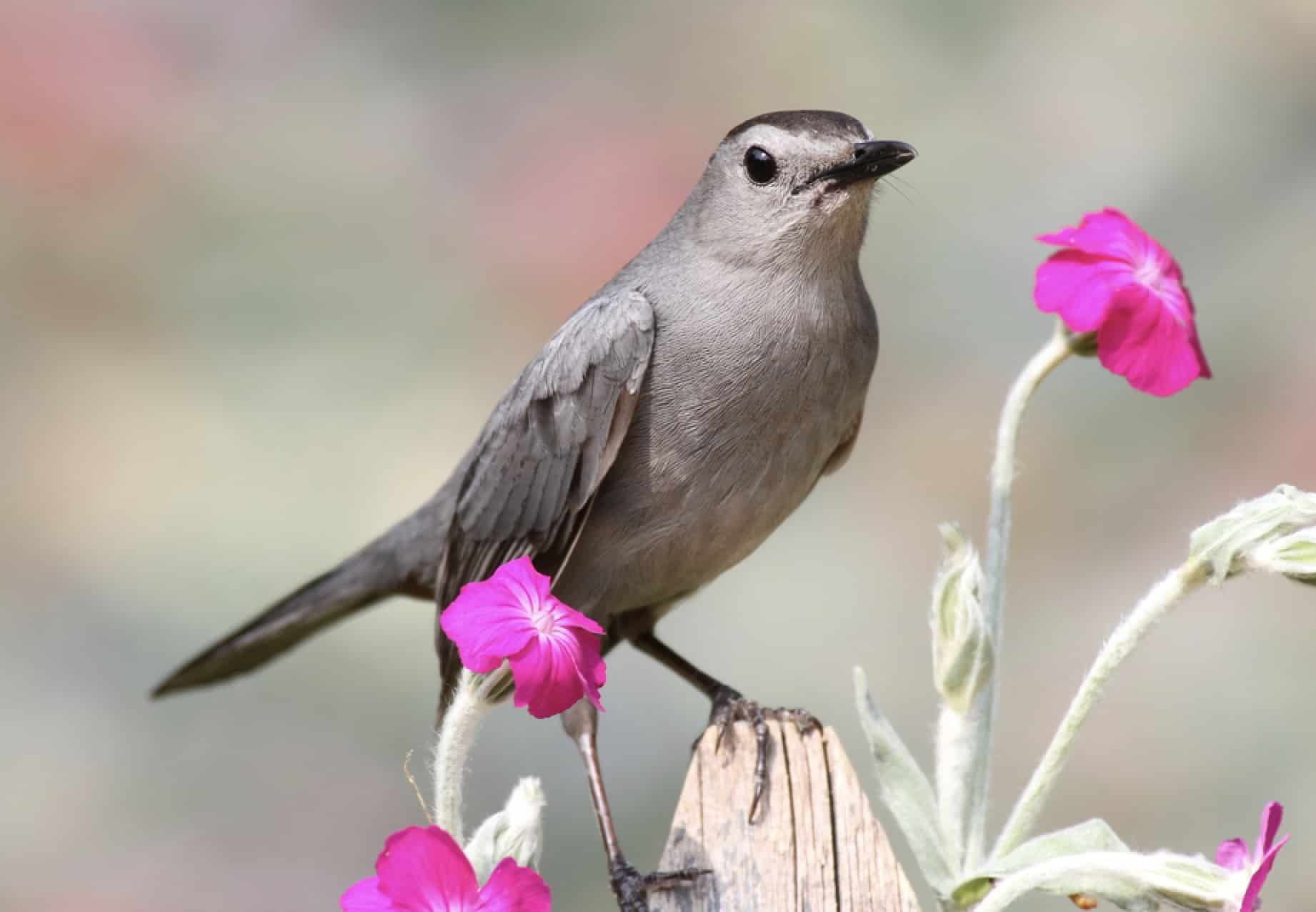| Bird Species & Scientific Name | Preferred Habitat | Geographic Location(s) | Physical Description |
|---|---|---|---|
| Black-capped Chickadee (Poecile atricapillus) | Deciduous and mixed forests | Northern and eastern U.S., extending into Canada | Small, with a distinctive black cap and bib, white cheeks, gray back and wings, and fluffy white underparts. |
| Tufted Titmouse (Baeolophus bicolor) | Woodlands, gardens, parks | Eastern and southeastern U.S. | Gray upper body with a white front, a small crest on the head, and large eyes. |
| White-breasted Nuthatch (Sitta carolinensis) | Deciduous forests and woodlands | Across the U.S., primarily in eastern and central regions | Compact body with a large head, black cap, white face, and chest, with a blue-gray back and sharp bill. |
| Carolina Chickadee (Poecile carolinensis) | Forests, suburban areas, parks | Southeastern U.S., overlapping with Black-capped Chickadee in some areas | Similar to the Black-capped Chickadee but with a slightly smaller size and a different song. |
| Dark-eyed Junco (Junco hyemalis) | Coniferous and mixed forests | Widespread across the U.S., especially in winter | Variable coloration but generally with a slate-gray body and a white belly, with a round head and a short, stout bill. |
| Mountain Chickadee (Poecile gambeli) | Mountainous forests | Western U.S., mainly in the Rocky Mountains and Sierra Nevada | Distinguished by its white eyebrow stripe, black cap and throat, gray back, and white underparts. |
| Bushtit (Psaltriparus minimus) | Woodlands, scrub, urban areas | Western U.S., from the Pacific Northwest to Texas | Tiny bird with a long tail, overall gray plumage, and a lighter underside. Males and females are similar but can have subtle differences in eye color. |
| Oak Titmouse (Baeolophus inornatus) | Oak and mixed woodlands | California, primarily in the state’s oak woodlands | Plain gray overall with a small crest, dark eyes, and a stout bill, similar in appearance to the Tufted Titmouse but without the white underparts. |
| Gray Catbird (Dumetella carolinensis) | Thickets, gardens, forest edges | Eastern and central U.S. during breeding season, winters in the Southeast and parts of Central America | Slate gray overall with a black cap, a dark tail, and a characteristic reddish patch under the tail. |
| American Tree Sparrow (Spizelloides arborea) | Open woodlands, fields, scrublands | Northern U.S. for breeding, winters further south to central U.S. | Rusty cap and eye line, gray face, and a small, round body with a bi-colored bill and a dark spot on the plain, light chest. |
Black-capped Chickadee
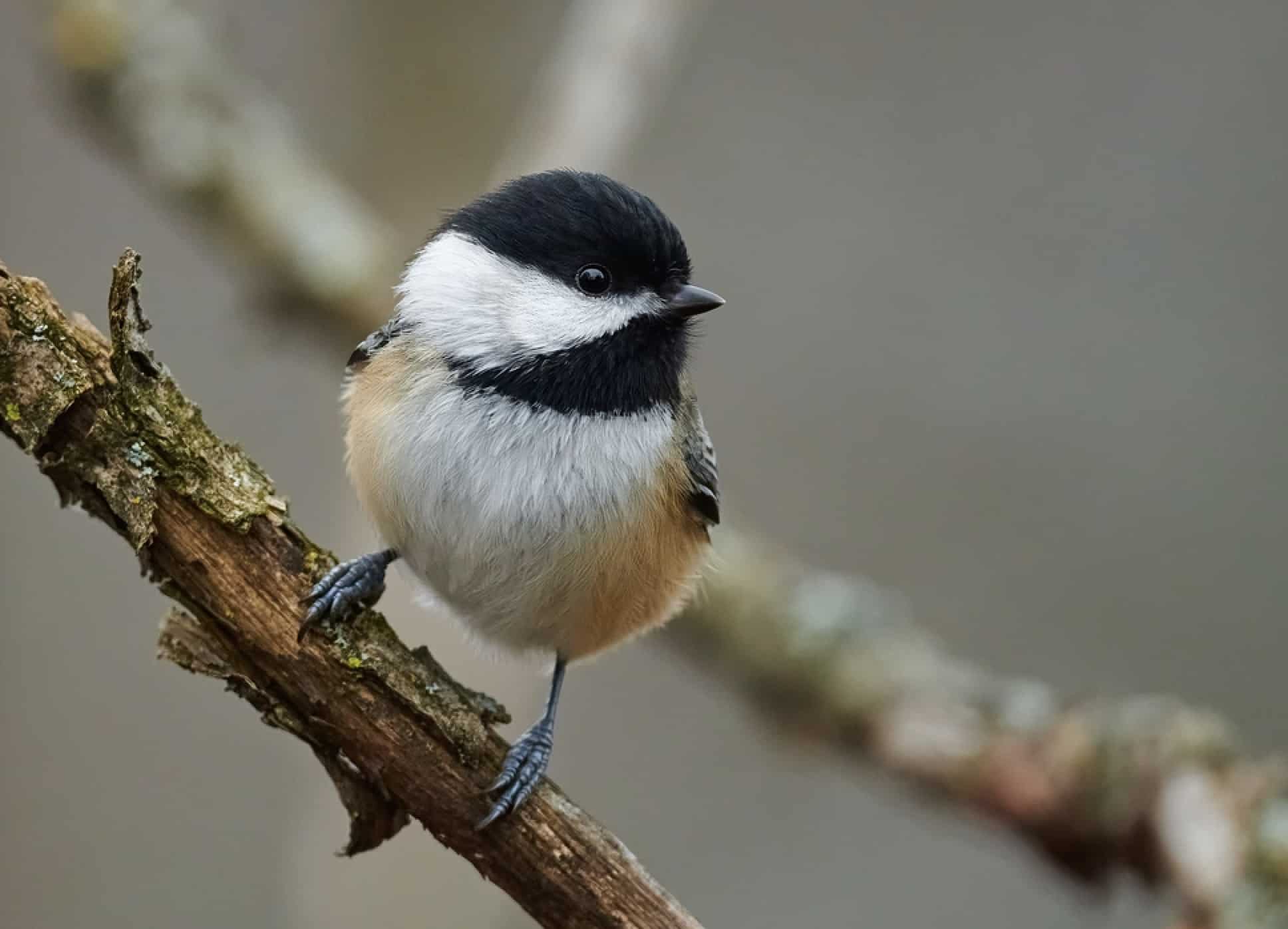
The Black-capped Chickadee (Poecile atricapillus) is a charming and easily recognizable bird, making it a favorite among bird watchers. Here’s the deets:
Identification
- Size and Shape: Black-capped Chickadees are small birds with a large head, tiny body, and a short neck. Their distinctive feature is their black cap and bib, with white cheeks, which makes them easily identifiable even for beginners.
- Color Pattern: They have a fluffy appearance with gray back, wings, and tail, and their underparts are soft white or pale gray.
Behavior
- Curious and Energetic: These birds are known for their curiosity and fearless nature, often approaching humans closely, especially in areas where they’re used to human presence.
- Vocalizations: Their familiar call, a high-pitched “chick-a-dee-dee-dee,” is where their name comes from. The number of “dee” notes can actually indicate the level of threat they perceive.
- Feeding: They are adept at hanging from tree branches and feeders, using their strong legs and feet, to pick seeds or insects. In winter, they often store food to retrieve later.
Habitat
- Wide Range: Black-capped Chickadees inhabit mixed deciduous and coniferous forests, parks, and backyards across North America, primarily in the northern United States and Canada.
- Nesting: They nest in tree cavities, often those previously used by woodpeckers or ones they excavate themselves in softwood. They fill the cavity with moss, hair, and other soft materials to cushion their eggs.
Conservation Status
- Stable Population: Currently, the Black-capped Chickadee is not considered at risk. Their ability to adapt to various habitats and conditions has helped maintain their numbers.
Tips for Watching
- Feeders: Attract them to your yard with sunflower seeds, suet, and peanut butter in feeders. They’re especially attracted to feeder setups that mimic their natural environment, like those with plenty of tree cover.
- Observation: To observe Black-capped Chickadees, stay quiet and minimize movements. They’re likely to come close, providing excellent opportunities for observation and photography.
- Record Keeping: Keep a journal of your sightings, noting behavior, numbers, and the conditions. This can help you learn their patterns and even contribute to citizen science projects.
Tufted Titmouse (Baeolophus bicolor)
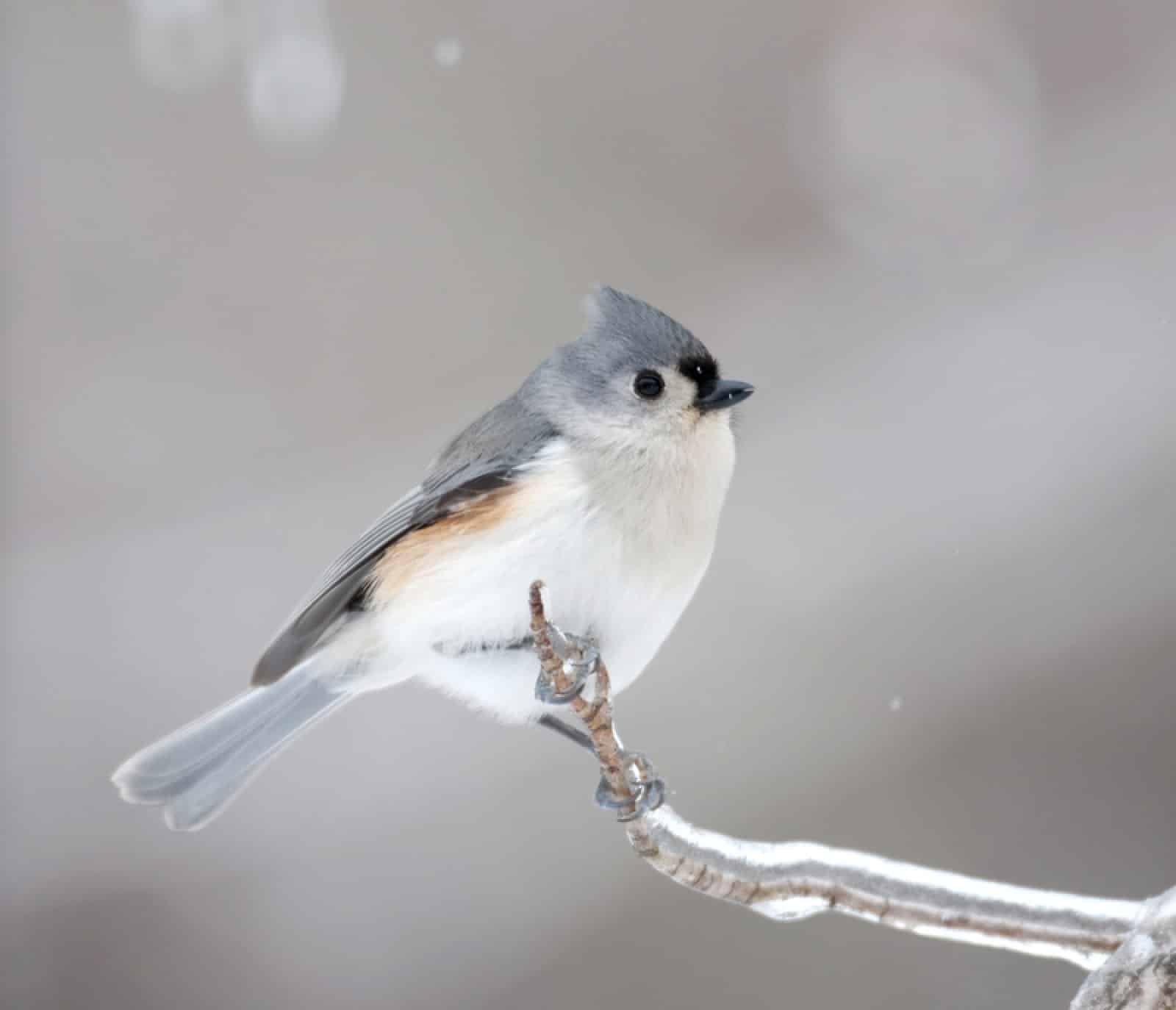
The Tufted Titmouse, with its lively antics and melodious calls, is a joy to watch. Their presence is a testament to the beauty and diversity of avian life, making them a cherished subject for bird watchers across their range.
Identification
- Size and Shape: Tufted Titmice are small to medium-sized birds characterized by their prominent crest (tuft) on the top of their head, which gives them a distinctive silhouette. They have a round body, large head, and a long tail.
- Color Pattern: They boast a soft gray upper body with a white front, accented by a rusty-colored area under the wings. Their eyes are large and dark, which stands out against their gray face.
Behavior
- Inquisitive and Bold: Similar to the Black-capped Chickadee, Tufted Titmice are curious about their surroundings and relatively fearless around humans, often visiting bird feeders in backyards.
- Vocalizations: Their song is a clear, whistled “peter-peter-peter,” and they have a variety of calls. Their vocal expressions are important for communicating within their species, especially during mating season.
- Feeding: These birds are primarily insectivores but will also eat seeds, berries, and nuts. They are adept at foraging in trees, often hanging upside down to reach their food.
Habitat
- Adaptable Dwellers: Tufted Titmice are found in deciduous and mixed forests, gardens, parks, and backyards throughout the eastern United States.
- Nesting: They nest in natural tree cavities or old woodpecker holes, lining their nests with soft materials like hair, moss, and cotton, making for a cozy environment for their eggs.
Conservation Status
- Stable and Growing: The Tufted Titmouse population is stable and has been increasing over the past few decades. Their adaptability to human-modified landscapes has likely contributed to their success.
Tips for Watching
- Feeders: Attracting them with sunflower seeds, peanuts, and suet in hanging feeders can make your backyard a favorite spot for Tufted Titmice.
- Patience Pays Off: They can be a bit shy at first, so patience and minimal movement can encourage them to come closer over time.
- Journaling: Documenting sightings, behavior, and vocalizations can enhance your bird-watching experience and contribute valuable information to bird conservation efforts.
White-breasted Nuthatch (Sitta carolinensis)
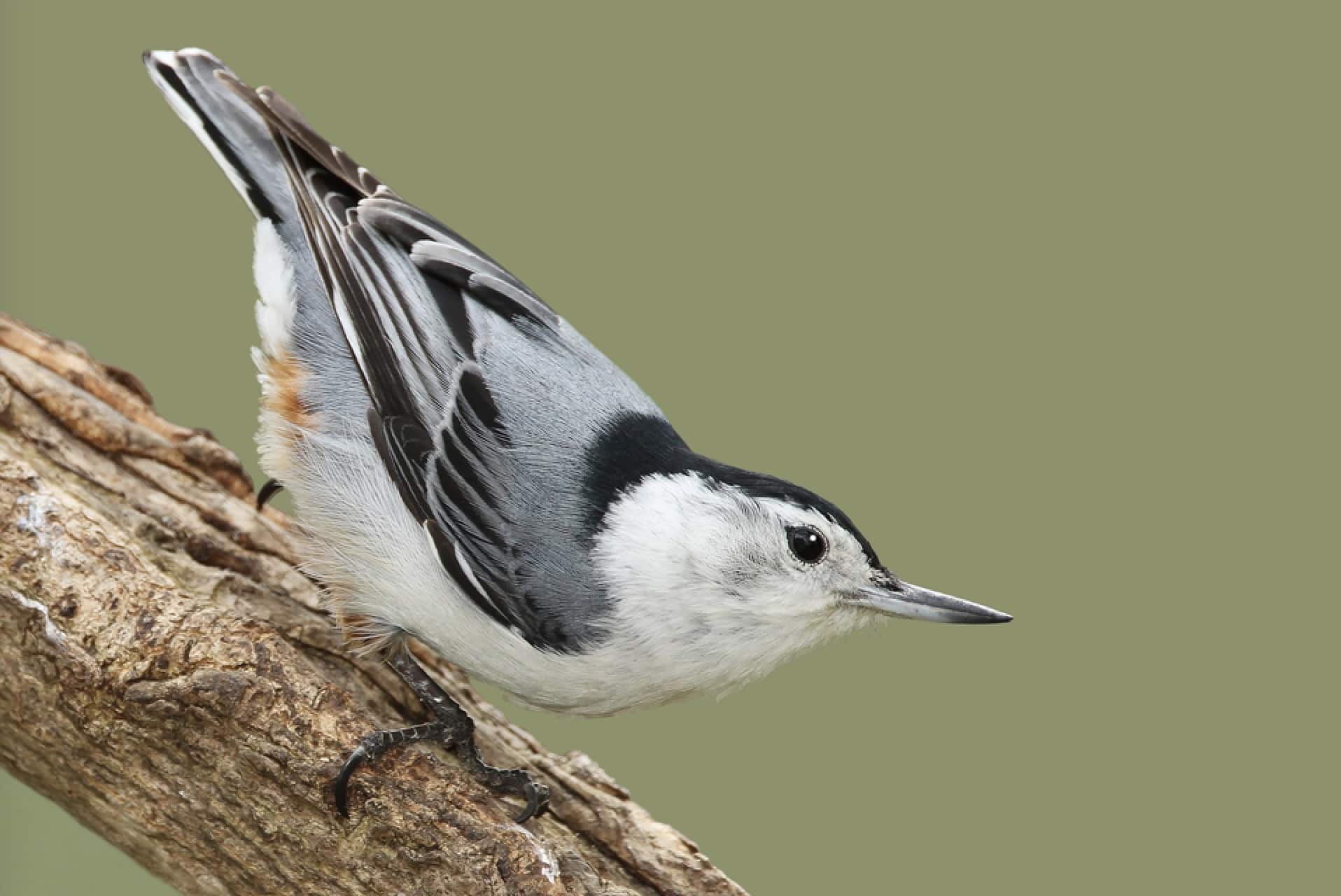
The White-breasted Nuthatch offers a distinctive bird watching experience with its unique behaviors, acrobatic foraging, and vocalizations. Their presence adds to the diversity and beauty of bird life in their habitats, making them a treasured find for bird enthusiasts.
Identification
- Size and Shape: White-breasted Nuthatches are small birds with a stout build. They have a large head, almost no neck, a short tail, and a strong, pointed beak.
- Color Pattern: They feature a striking white breast and face, contrasted with a blue-gray back and a black cap. Their underparts are a soft white or light gray, making their overall appearance quite distinctive.
Behavior
- Agility and Acrobatics: Known for their ability to walk down tree trunks headfirst, White-breasted Nuthatches are agile birds that navigate the bark of trees with ease, unlike many other birds.
- Vocalizations: Their calls are a sharp “ank-ank” sound, and their songs are a series of fast, nasal notes. These sounds are often heard throughout their habitat, signaling their presence.
- Feeding: Primarily insectivores, they forage for insects hidden in crevices in tree bark but will also eat seeds and nuts, especially in the colder months. They are known to cache food in tree bark for later consumption.
Habitat
- Diverse Environments: These nuthatches inhabit deciduous and mixed forests, as well as wooded parks and residential areas across much of the United States.
- Nesting: They nest in cavities, either natural or old woodpecker holes, and they line their nest with bark strips, feathers, and other soft materials. They often smear insects around the entrance of their nest hole, possibly to deter predators.
Conservation Status
- Generally Stable: The population of the White-breasted Nuthatch is considered stable across its range, with no immediate conservation concerns. Their adaptability to different habitats, including urban areas, contributes to their stable status.
Tips for Watching
- Look Down: Spotting these nuthatches often means looking down the trunk of a tree rather than up into its branches, a unique aspect of bird watching for this species.
- Feeder Attraction: They are attracted to feeders with sunflower seeds, peanuts, and suet. Providing a feeder with a rough surface or bark-like texture can mimic their natural foraging preference.
- Observation and Patience: Their unique foraging behavior and the ability to observe them at close quarters make them a fascinating subject for bird watchers. Patience and quiet observation can yield rewarding views and behaviors.
The Carolina Chickadee (Poecile carolinensis)
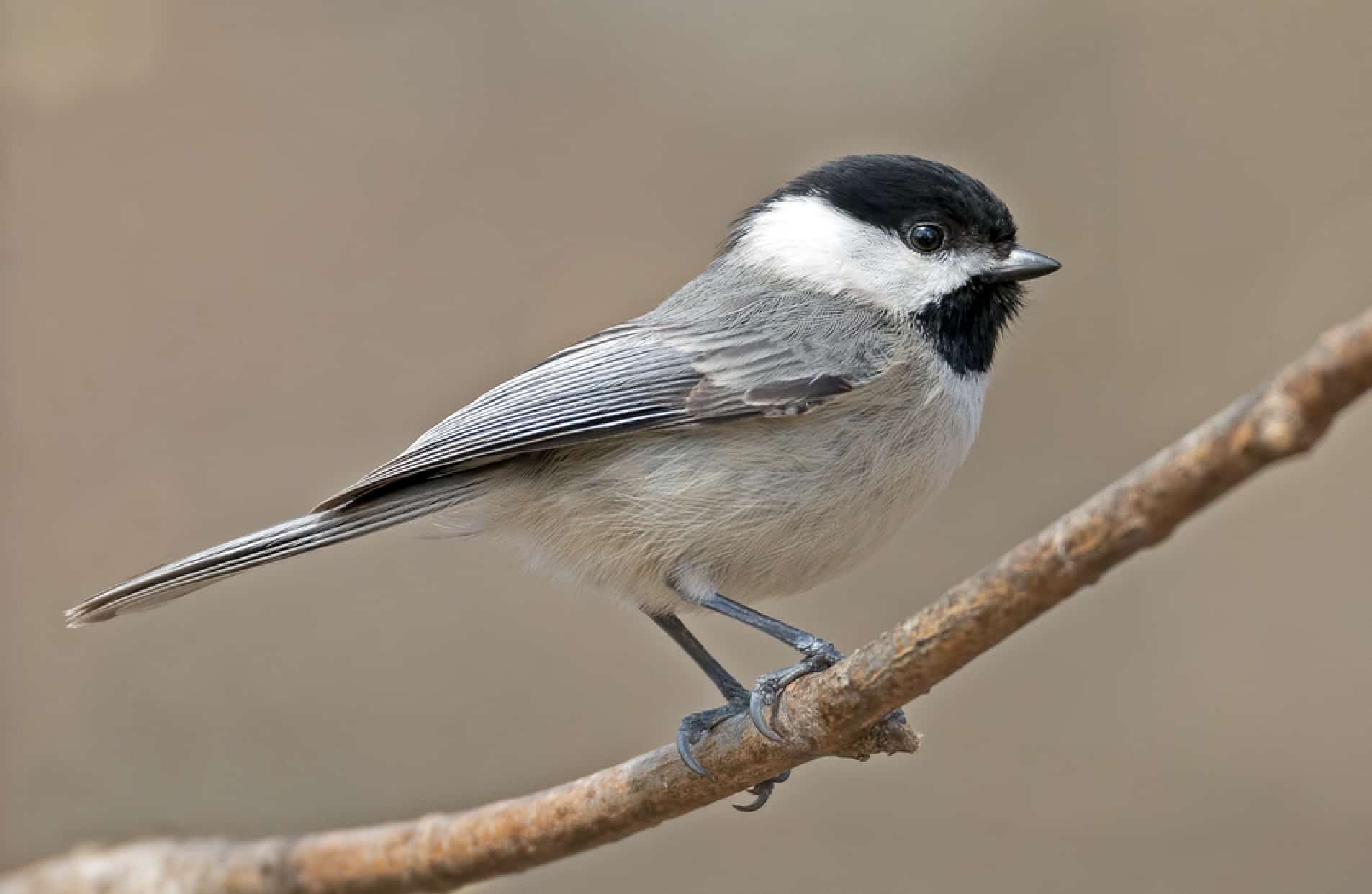
The Carolina Chickadee (Poecile carolinensis) is a delightful bird, closely related to the Black-capped Chickadee but with its own unique traits and characteristics. Here’s an insightful overview for bird watchers interested in this small yet charismatic bird:
Identification
- Size and Shape: Carolina Chickadees are tiny birds with a big-headed appearance and a short neck. They possess a small body, a large head, and a long, narrow tail.
- Color Pattern: They have a distinctive black cap and bib, with bright white cheeks. Their underparts are a soft gray or buffy white, and their back and wings are gray.
Behavior
- Social and Vocal: These chickadees are very social and are known for their complex vocalizations. Their “chick-a-dee-dee-dee” call is similar to that of the Black-capped Chickadee, with slight regional variations.
- Feeding Habits: Carolina Chickadees are adept at foraging for insects and spiders in trees and shrubs. They also consume seeds and berries, and they readily visit bird feeders for sunflower seeds, suet, and other offerings.
- Agility: Like their Black-capped relatives, they are capable of hanging upside down to glean food from the undersides of branches and leaves.
Habitat
- Range and Environment: This species is primarily found in the southeastern United States, inhabiting deciduous and mixed forests, as well as suburban and backyard settings.
- Nesting: Carolina Chickadees nest in cavities, either natural or excavated by woodpeckers. They often line their nests with moss, hair, and other soft materials, and they may use artificial nest boxes if available.
Conservation Status
- Stable: The Carolina Chickadee population is currently stable, with no significant threats identified. Their adaptability to human-modified landscapes has helped maintain their numbers.
Tips for Watching
- Feeder Setup: Attract Carolina Chickadees to your backyard with tube feeders or suet feeders filled with their favorite foods. They are particularly fond of black oil sunflower seeds.
- Quiet Observation: These birds can become quite accustomed to human presence, especially in areas where they are regularly fed. Quiet and patient observation can lead to close encounters.
- Listen for Vocalizations: Learning their various calls and songs can make it easier to detect their presence in a densely wooded area or even in your own backyard.
The Carolina Chickadee’s cheerful demeanor and lively social interactions make it a favorite among bird watchers in the southeastern U.S. Their presence signals a healthy, vibrant ecosystem, and observing these birds in their natural habitat can be a highly rewarding experience for bird enthusiasts.
Dark-eyed Junco (Junco hyemalis)
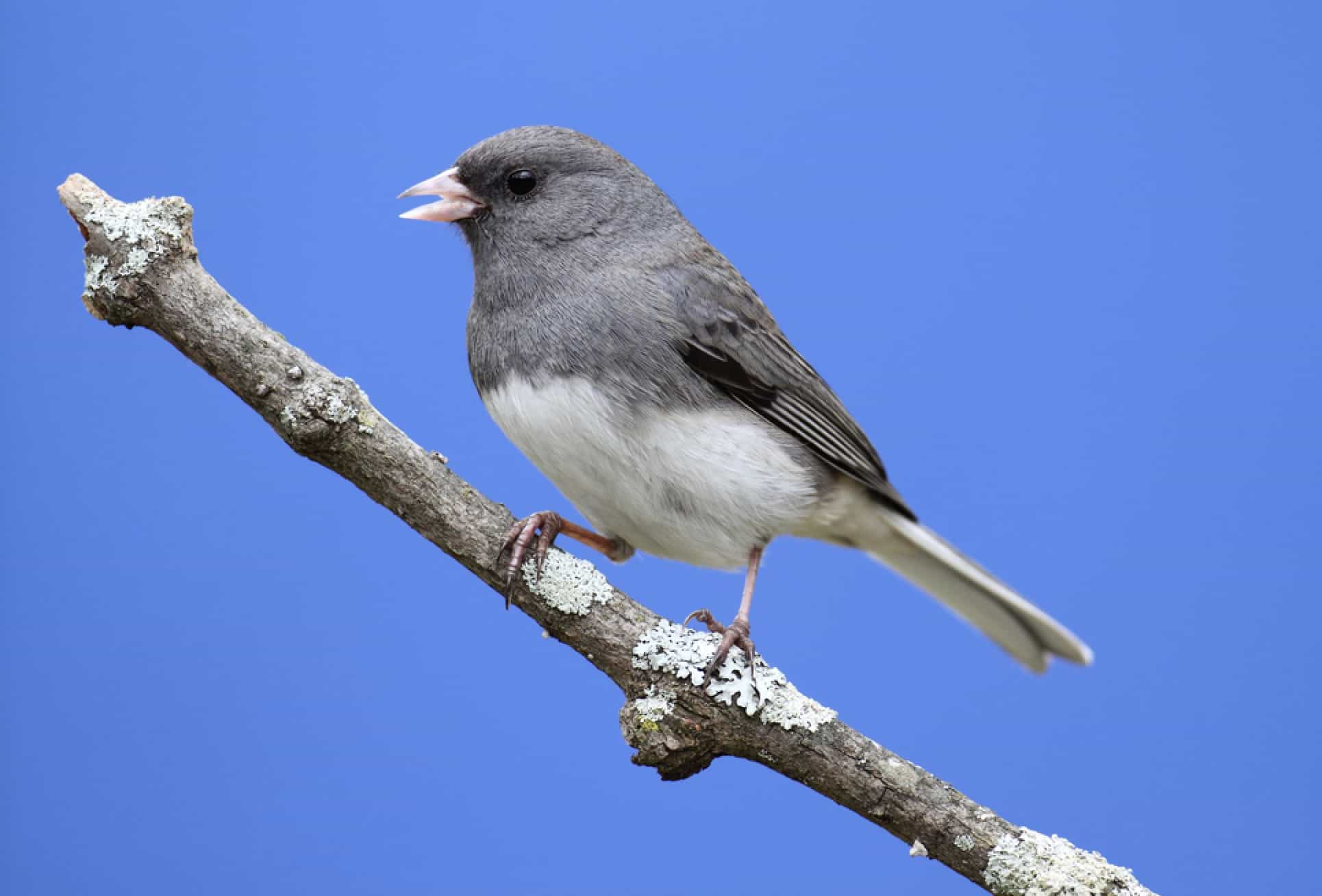
The Dark-eyed Junco (Junco hyemalis) is a widely recognized and beloved bird, especially known for signaling the change of seasons in many areas. Let’s dive into the details of this charming bird:
Identification
- Size and Shape: Dark-eyed Juncos are small, round birds with a stout body, a short, thick beak, and a fairly long, conspicuous tail.
- Color Pattern: They exhibit a variety of color patterns across different regions, but most have a striking contrast of light bellies and dark upper parts. The most common variety, the Slate-colored Junco, has a sleek, slate-gray body and a white belly.
Behavior
- Ground Foragers: Juncos are primarily seen hopping on the ground, foraging for seeds and insects. Their movement on the ground is as distinctive as their appearance.
- Vocalizations: Their songs are a beautiful trill, similar to the sound of a ringing bell. They also have a variety of calls, including sharp “ticks” used to alert others to danger or to communicate within a flock.
- Social Birds: During winter, they often form large flocks with a clear pecking order. Watching their interactions at feeders can be particularly entertaining.
Habitat
- Versatile Dwellers: Dark-eyed Juncos are found in a wide range of habitats, including coniferous woods, fields, parks, and gardens. They’re common across much of North America, especially noticeable in winter when they migrate to lower elevations and more southern locations.
- Nesting: They nest on the ground, making a well-hidden nest among the roots of trees or shrubs, lined with fine grasses and hair.
Conservation Status
- Robust Population: The Dark-eyed Junco is one of the most common birds in North America. Their population is stable, and they adapt well to human-altered landscapes.
Tips for Watching
- Feeder Attraction: To attract Juncos to your yard, scatter seeds, particularly millet, on the ground or on platform feeders.
- Observe Flock Dynamics: Watching a flock of Juncos can provide insights into their social structure. Look for dominant and submissive behaviors among birds at your feeder.
- Patience and Observation: Since they’re ground feeders, look for Juncos foraging under feeders or in open areas with sparse vegetation. Their subtle beauty and social interactions are best appreciated with patient observation.
Dark-eyed Juncos are a joy to observe, offering a blend of subtle elegance and social complexity. Their presence is a reminder of the natural cycles and rhythms of the seasons, making them a favorite among bird watchers and nature enthusiasts alike.
Mountain Chickadee (Poecile gambeli)
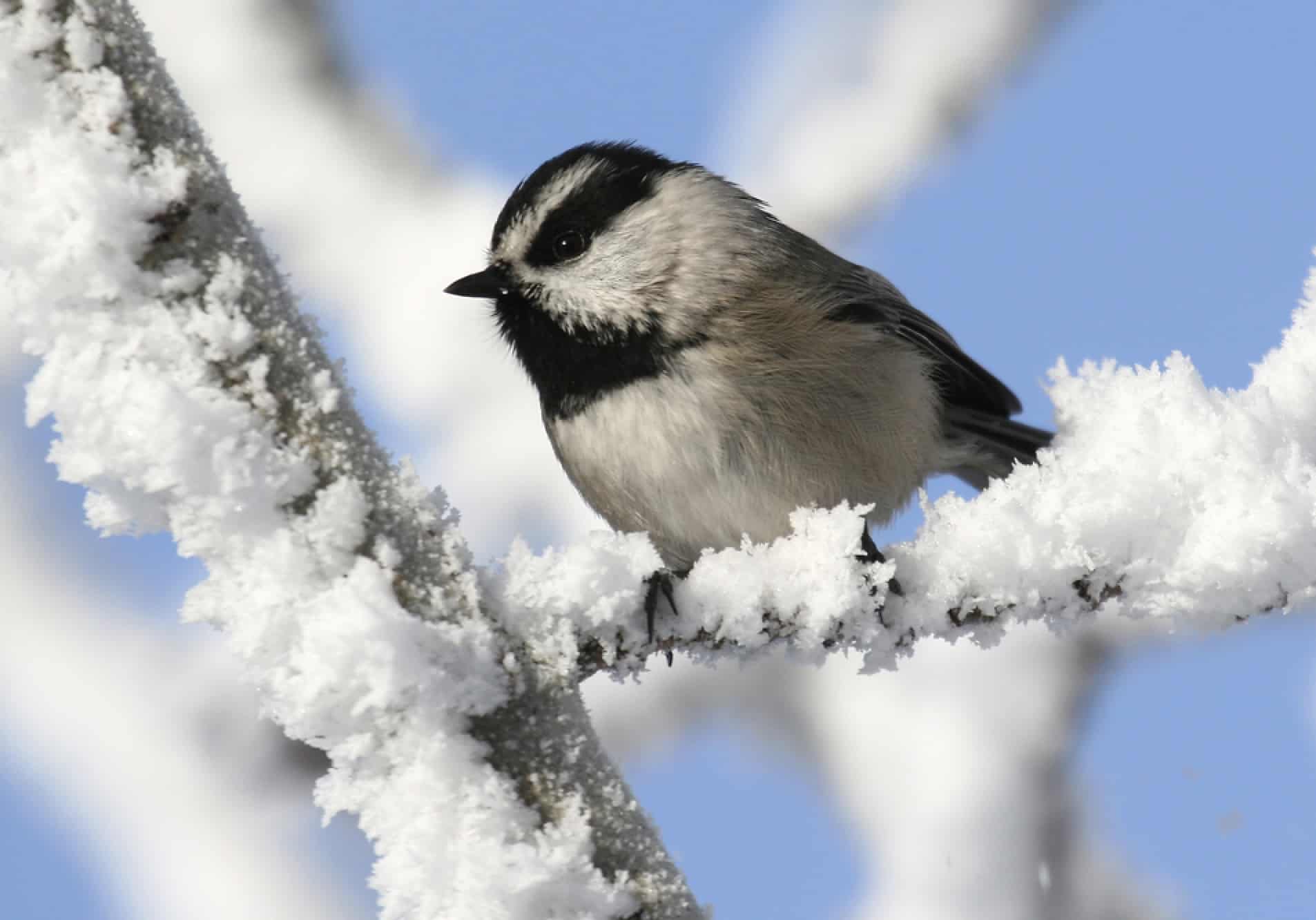
The Mountain Chickadee (Poecile gambeli) is a delightful and hardy little bird that thrives in the mountainous regions of western North America. They are emblematic of the rugged, scenic landscapes they inhabit. Observing these spirited birds offers a glimpse into the complex ecosystem of mountain forests and the adaptability of wildlife to diverse and challenging environments.
Identification
- Size and Shape: Mountain Chickadees are small birds with a big head, a short neck, and a plump body. They have a distinctive black cap and bib, with white cheeks, similar to their Black-capped cousins but with an additional white eyebrow stripe that sets them apart.
- Color Pattern: Their upper parts are gray, and their underparts are paler, with a white front. The striking black and white head pattern is the most distinctive feature for identification.
Behavior
- Curiosity and Adaptability: Like other chickadees, Mountain Chickadees are curious and adaptable, often investigating humans and human habitations. They are adept at surviving in cold temperatures, storing food for winter use.
- Vocalizations: Their calls include a sharp “chick-a-dee-dee-dee” similar to other chickadees, but they also have a unique, high-pitched “see-bee” song. Their vocalizations play a crucial role in communication within the species.
- Feeding: They forage in trees for insects, seeds, and berries. In winter, they can be seen hanging upside down on branches to reach food, and they readily visit feeders for sunflower seeds, nuts, and suet.
Habitat
- Mountain Forests: True to their name, Mountain Chickadees are found in high elevation forests, especially areas with coniferous trees like pine, spruce, and fir. They are residents of mountainous areas in the western United States and Canada.
- Nesting: They nest in tree cavities, either natural holes or old woodpecker nests, lining the interior with soft materials. They are known to excavate their own nesting sites in soft or rotten wood.
Conservation Status
- Stable Population: The population of the Mountain Chickadee is stable. Their adaptability to harsh winter conditions and a wide range of elevations helps maintain their numbers.
Tips for Watching
- Elevation Matters: To observe Mountain Chickadees, venture into mountainous areas or high-altitude forests. They are more likely to be found at elevations above 3,500 feet.
- Feeder Strategy: If you live in their range, attract them with black oil sunflower seeds, peanut pieces, and suet placed in feeders at higher elevations.
- Patience in Observation: Watching for their unique feeding behaviors and listening for their distinctive calls can be rewarding. They are often found in mixed-species flocks, so look for them among other mountain forest birds.
The Oak Titmouse (Baeolophus inornatus)
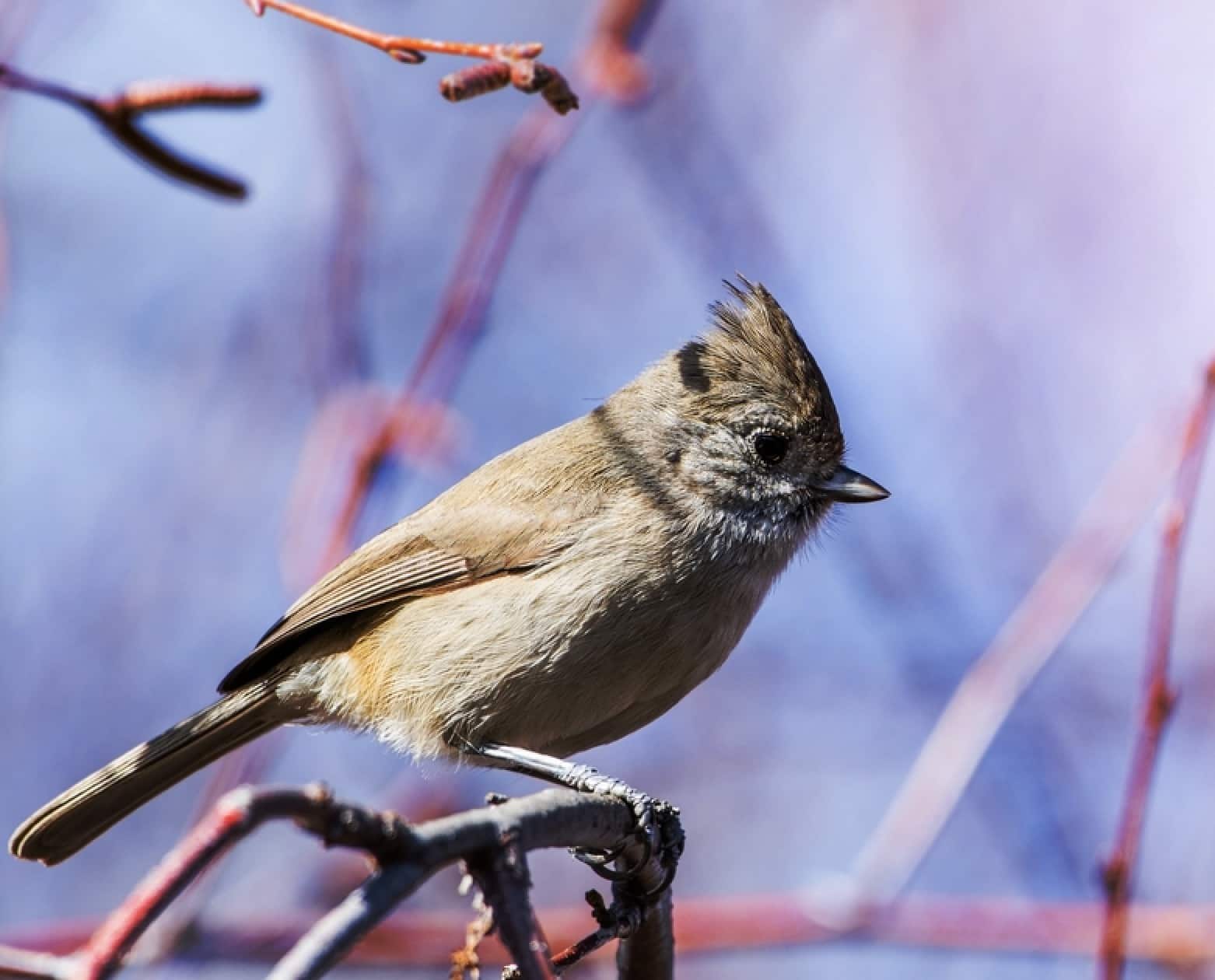
The Oak Titmouse (Baeolophus inornatus) is a small, engaging bird found in the oak woodlands of California and the western United States. Their subtle appearance belies a lively personality, making them a delight to observe for bird enthusiasts. Here’s a closer look at the Oak Titmouse:
Identification
- Size and Shape: The Oak Titmouse is a small bird with a large head, a short neck, and a long tail. They possess a pointed crest on the head, which adds to their distinctive profile.
- Color Pattern: They are mostly gray with a lighter underbelly and have a subtle rust-colored wash under their wings. Unlike some of their more vividly colored relatives, their coloring is understated, helping them blend into their oak woodland habitats.
Behavior
- Curious and Bold: Oak Titmice are known for their curiosity and lack of fear around humans, often investigating feeders and even interacting with people in their quest for food.
- Vocalizations: Their song is a series of clear, whistled notes, and they also make a sharp “pit-pit” call. Their vocal behavior is essential for communicating within their species, especially during mating seasons and when asserting territory.
- Feeding: They primarily feed on insects and spiders but will also consume seeds and fruits. Their foraging behavior is agile and acrobatic, often seen hanging upside down to extract food from bark crevices.
Habitat
- Specialized Habitat: Oak Titmice are closely associated with oak woodlands but also inhabit mixed woodlands with a significant oak component. Their range is relatively limited compared to some other titmouse species, focused mainly in California and the surrounding areas.
- Nesting: They nest in cavities, either natural or excavated by other species like woodpeckers. Their nests are made from a variety of materials, including hair, feathers, and grasses, creating a soft bed for their eggs.
Conservation Status
- Stable but Watchful: The Oak Titmouse population is considered stable, but because of their specific habitat requirements, they are susceptible to habitat loss and fragmentation. Conservation efforts focus on preserving oak woodlands to support their populations.
Tips for Watching
- Feeder Tips: Attract Oak Titmice with suet and sunflower seeds. They are particularly drawn to feeders in or near oak woodlands, their natural habitat.
- Patience and Observation: While they are less shy around humans, their small size and the dense habitats they prefer can make them a bit more challenging to spot. Quiet observation and a bit of patience can lead to rewarding views.
- Record Your Observations: Keeping a log of your sightings, including behavior and vocalizations, can enhance your understanding and enjoyment of these spirited birds.
Observing the Oak Titmouse in its natural habitat offers a window into the dynamic ecosystems of oak woodlands. Their lively antics, curiosity, and the sweet simplicity of their song make them a captivating subject for bird watchers and nature lovers.
The Gray Catbird (Dumetella carolinensis)
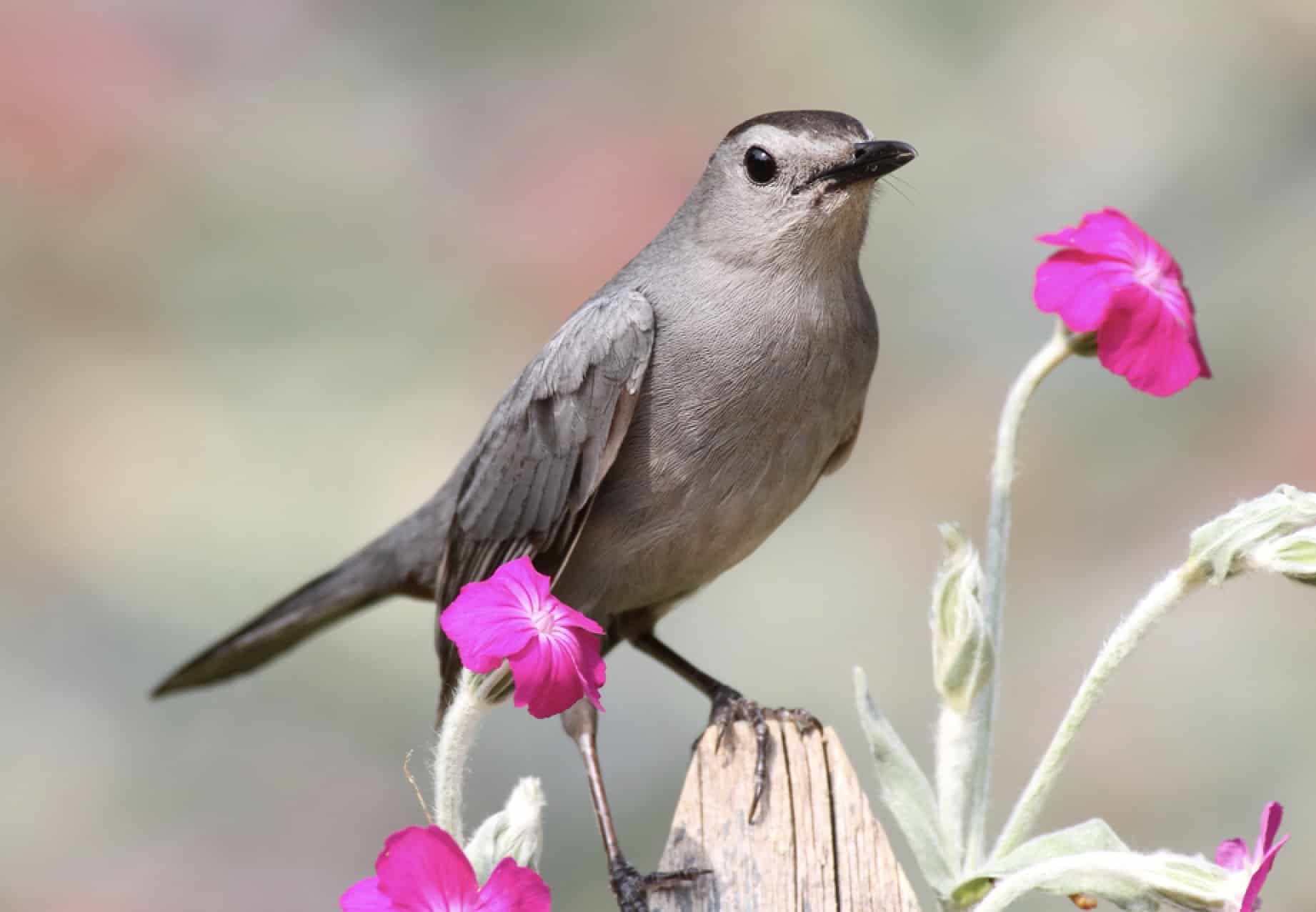
The Gray Catbird (Dumetella carolinensis) is a fascinating and somewhat mysterious bird, known for its remarkable vocal abilities and distinctive appearance. Let’s explore the intriguing world of the Gray Catbird:
Identification
- Size and Shape: Gray Catbirds are medium-sized, slender birds with a long tail and a rounded body. They have a black cap and a slender bill, typical of many songbirds.
- Color Pattern: As the name suggests, they are mostly gray with a small black cap. A notable feature is the reddish-brown patch under their tail, which is often only visible during flight or when they flick their tails.
Behavior
- Mimicry Masters: Catbirds are among the best mimics in the bird world. They can imitate the songs and calls of other birds, as well as mechanical noises and even human-made sounds, weaving them into their own unique songs.
- Vocalizations: Their most distinctive call sounds like a cat’s meow, which is how they got their name. This call, combined with their complex and variable song, makes them a joy for bird listeners.
- Feeding: They are omnivores, feeding on a wide variety of insects, fruits, and berries. Catbirds are especially fond of dense shrubbery where food is plentiful and they can stay hidden.
Habitat
- Thicket Lovers: Gray Catbirds prefer dense thickets, hedgerows, and areas with abundant shrubbery. They are commonly found in gardens, parks, and forest edges across eastern North America and migrate to the southeastern United States, Mexico, Central America, and the Caribbean for winter.
- Nesting: They build their nests in dense shrubs, using twigs, grass, and leaves. The nest’s hidden location helps protect their eggs and young from predators.
Conservation Status
- Generally Stable: The Gray Catbird population is stable, thanks in part to their adaptability to various habitats, including suburban and urban areas. However, maintaining dense thickets and shrublands is crucial for their nesting and feeding.
Tips for Watching
- Create Habitat: Planting native shrubs and creating dense plantings in your garden can attract Gray Catbirds and give you a chance to observe them up close.
- Listen for Their Song: Learning their varied songs and calls, especially the distinctive cat-like meow, can help you locate these elusive birds even if they are hidden in dense foliage.
- Patience is Key: Because they prefer dense cover, spotting a Gray Catbird might take some time. Listening for their song and quietly waiting can often lead to a sighting.
The Gray Catbird’s secretive nature, combined with its beautiful mimicry and distinct calls, make it a captivating subject for bird watchers. Their presence adds a layer of depth and mystery to the habitats they occupy, offering endless fascination for those who seek to understand them better.
The American Tree Sparrow (Spizelloides arborea)
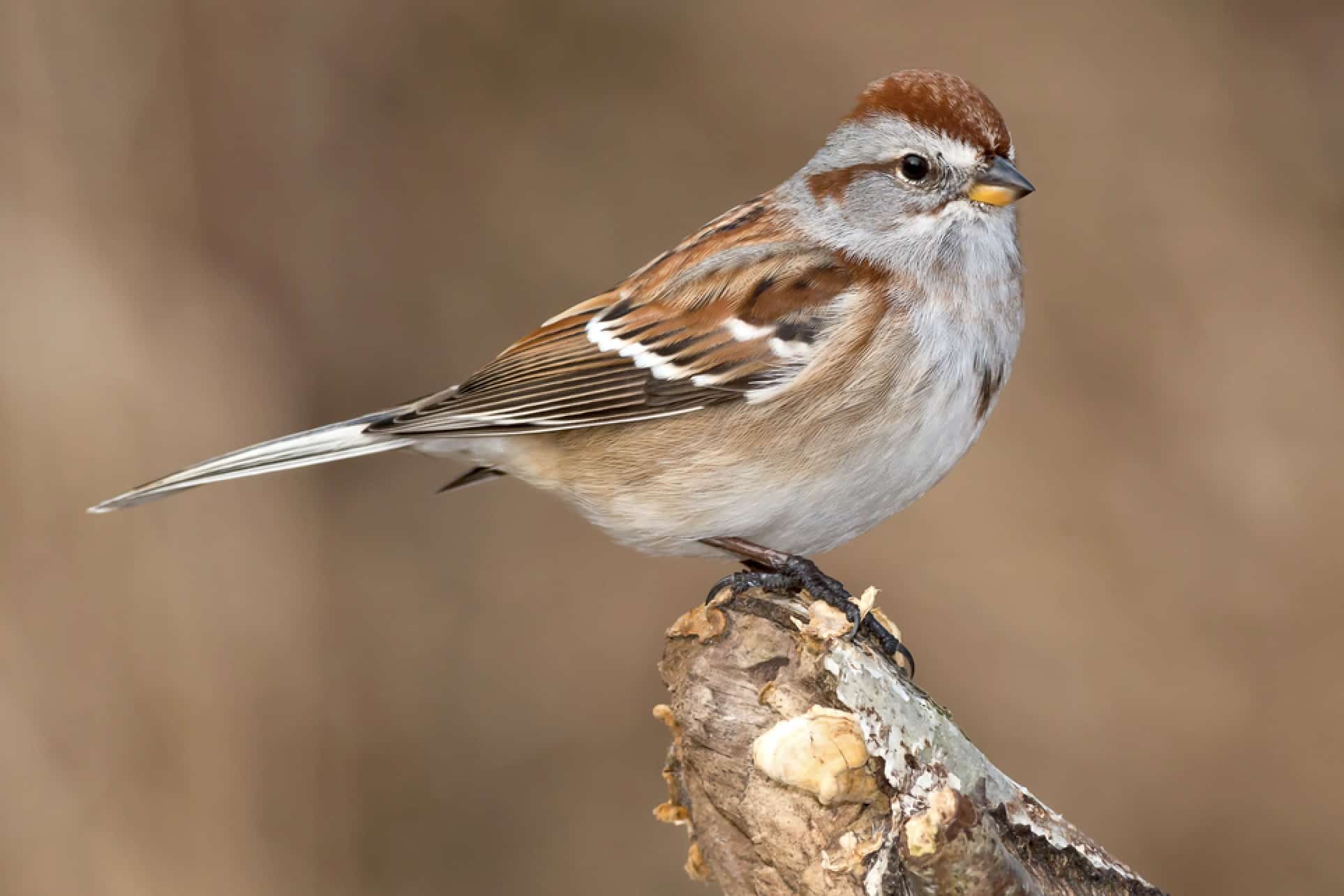
The American Tree Sparrow (Spizelloides arborea) is a charming bird, especially beloved by bird watchers during the colder months. Its arrival often heralds the beginning of winter in many areas. Let’s delve into the characteristics and habits of this little-known sparrow:
Identification
- Size and Shape: American Tree Sparrows are small birds with a rounded body, a long, notched tail, and a fairly small bill that’s adapted to both seed-eating and insect-catching.
- Color Pattern: They have a rusty cap and eye line, with a gray face and underparts. One of their most distinctive features is the dark spot on their otherwise clear breast, and they have a bicolored bill with a dark upper mandible and a yellow lower one.
Behavior
- Adaptable Feeders: In the winter, these sparrows primarily eat seeds of grasses and weeds, but during the breeding season, they switch to insects. They forage on the ground, often in flocks during the non-breeding season.
- Vocalizations: Their song is a sweet, high-pitched series of notes, and their calls include a soft, musical chirp. These sounds can add a lively atmosphere to their habitats, even in the chill of winter.
- Migration: American Tree Sparrows are migratory birds. They breed in the Arctic tundra and winter across much of the United States, making them a seasonal treat for many bird watchers.
Habitat
- Tundra to Fields: During the breeding season, they inhabit the open tundra, choosing areas with willows and other low shrubs. In winter, they are found in weedy fields, along roadsides, and in gardens, where food is abundant.
- Nesting: Their nests are on the ground, hidden in dense vegetation, and made from grasses and lined with fine materials like feathers.
Conservation Status
- Stable with Concerns: While the American Tree Sparrow is not currently considered at risk, like many Arctic-breeding birds, they face challenges from climate change and habitat loss. Monitoring their populations is essential for conservation efforts.
Tips for Watching
- Feeder Attraction: To attract them to your yard, try scattering millet or other small seeds on the ground or in platform feeders.
- Look for Flocks: In winter, look for American Tree Sparrows in large mixed flocks with other sparrows and finches. Their distinctive rusty cap and single breast spot help distinguish them from other sparrows.
- Patience and Quiet: These sparrows can be a bit shy, so watching them from a distance with binoculars in quiet areas can increase your chances of seeing them.
American Tree Sparrows offer a delightful glimpse into the adaptability and resilience of nature. Their presence enlivens winter landscapes, providing bird watchers with ample opportunities to enjoy their sweet songs and social behaviors.
